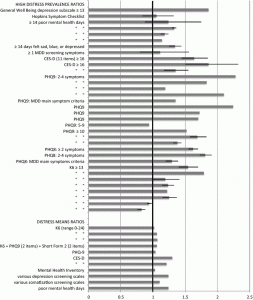
Black–White distress prevalence ratios with 95% confidence intervals (where estimable). CES-D Center for Epidemiologic Studies—depression, PHQ Patient Health Questionnaire, K6 Kessler 6
Former Cluster doctoral student David Barnes, now with the Icahn School of Medicine at Mount Sinai, and current faculty member Lisa Bates recently published a systematic review in the journal Social Psychiatry and Psychiatric Epidemiology investigating racial patterns in psychological distress and depression. Studies in the U.S. find a consistent “paradox” by which psychiatric outcomes such as major depressive disorder (MDD) are less prevalent among Blacks relative to Whites, despite greater exposure to social and economic stressors and worse physical health outcomes.
Barnes and Bates conducted a systematic review of research papers estimating the prevalence of MDD and papers estimating levels of psychological distress in Blacks and Whites in the U.S. Their review found consistently higher levels of psychological distress among Blacks than Whites which supports the existence of a “double paradox”. The first paradox, from the perspective of the social stress paradigm, is that despite having a disadvantaged social status in the US, Blacks have a lower prevalence of major depression than Whites. The second paradox is that Black–White comparisons of distress are discordant with Black–White comparisons of major depression despite evidence in the broader literature of a strong positive association between major depression and distress.
Abundant theories have been proposed in the literature to explain the lower prevalence of major depression in Blacks compared with Whites, and of those tested, none has been empirically supported. Nevertheless, to succeed these theories should also account for Blacks’ higher levels of distress levels, which they do not do. For instance, theories positing that ostensibly protective factors against depression (e.g., religiosity) that are also more prevalent in Blacks than Whites in the U.S. would need to also explain why these factors do not protect against distress among Blacks. This is particularly challenging given the overlapping symptom content in diagnostic interviews for depression and distress scales. Alternatively, Barnes and Bates posit that the diagnostic algorithm for major depression provides multiple opportunities for differential misclassification bias that could conceivably account for the apparent lower prevalence of depression in Blacks. These same opportunities for differential misclassification are not built into measures of distress. In sum the “double paradox” is consistent with the idea that the apparent lower prevalence of depression among Blacks is an artifact of how we measure depression.

